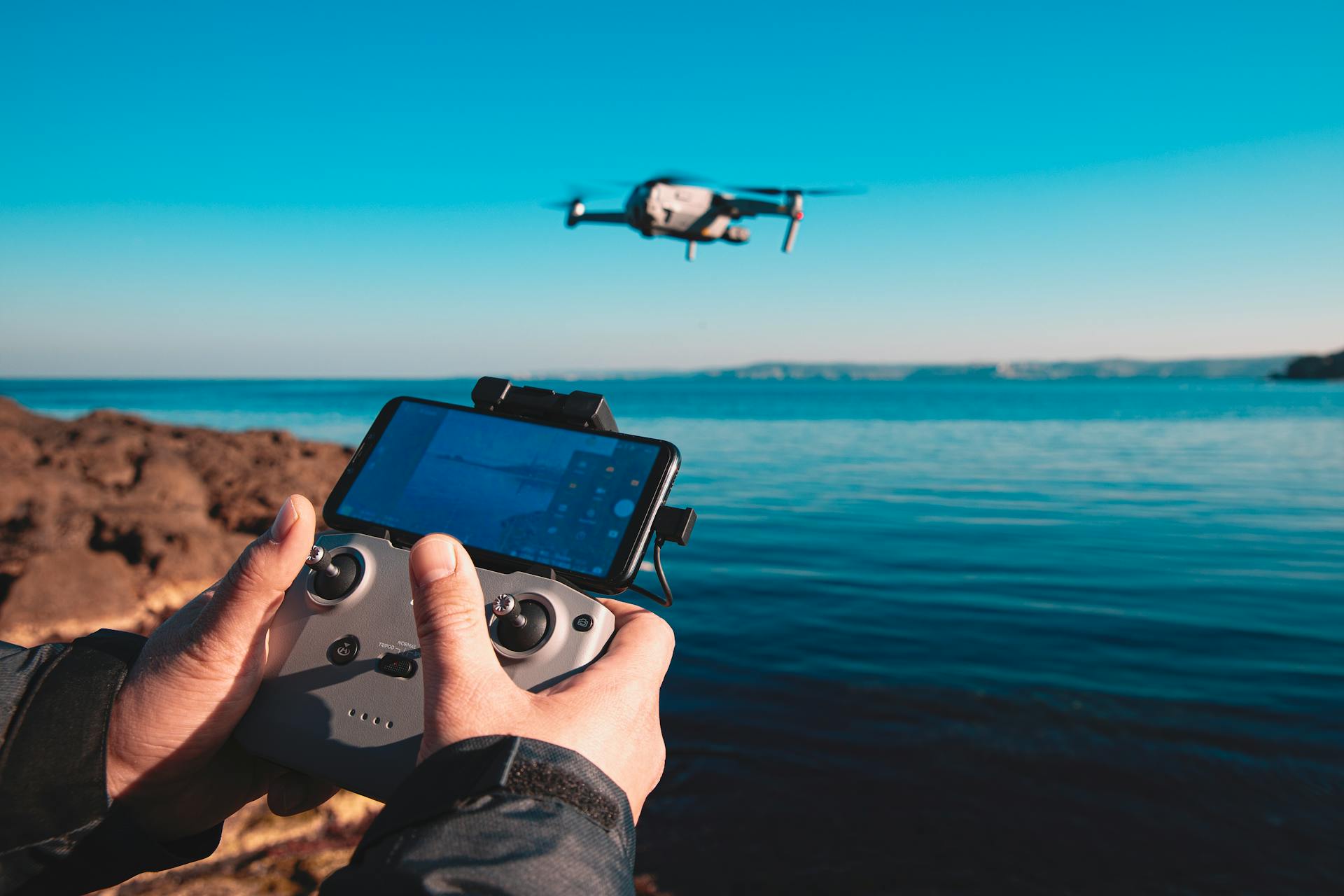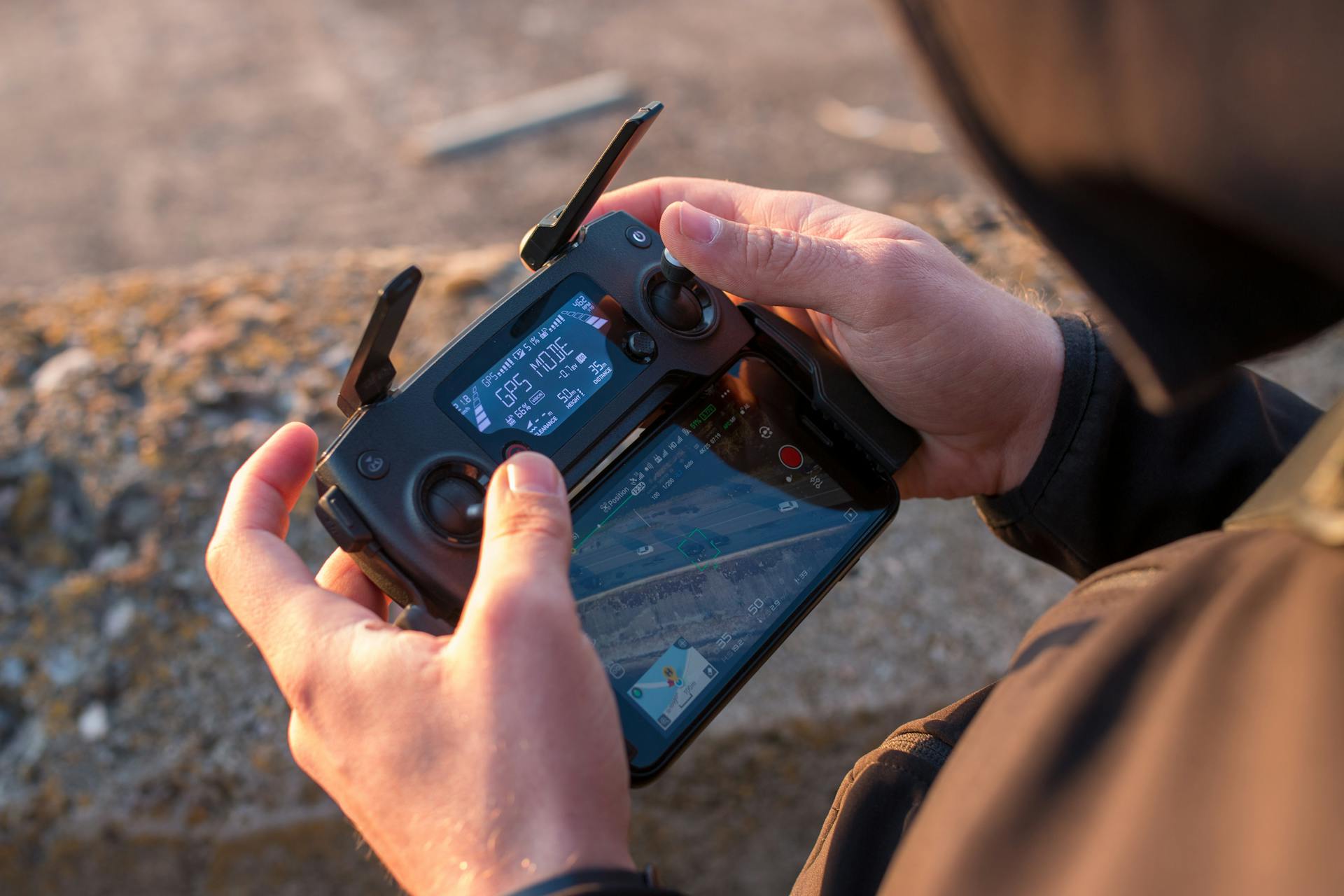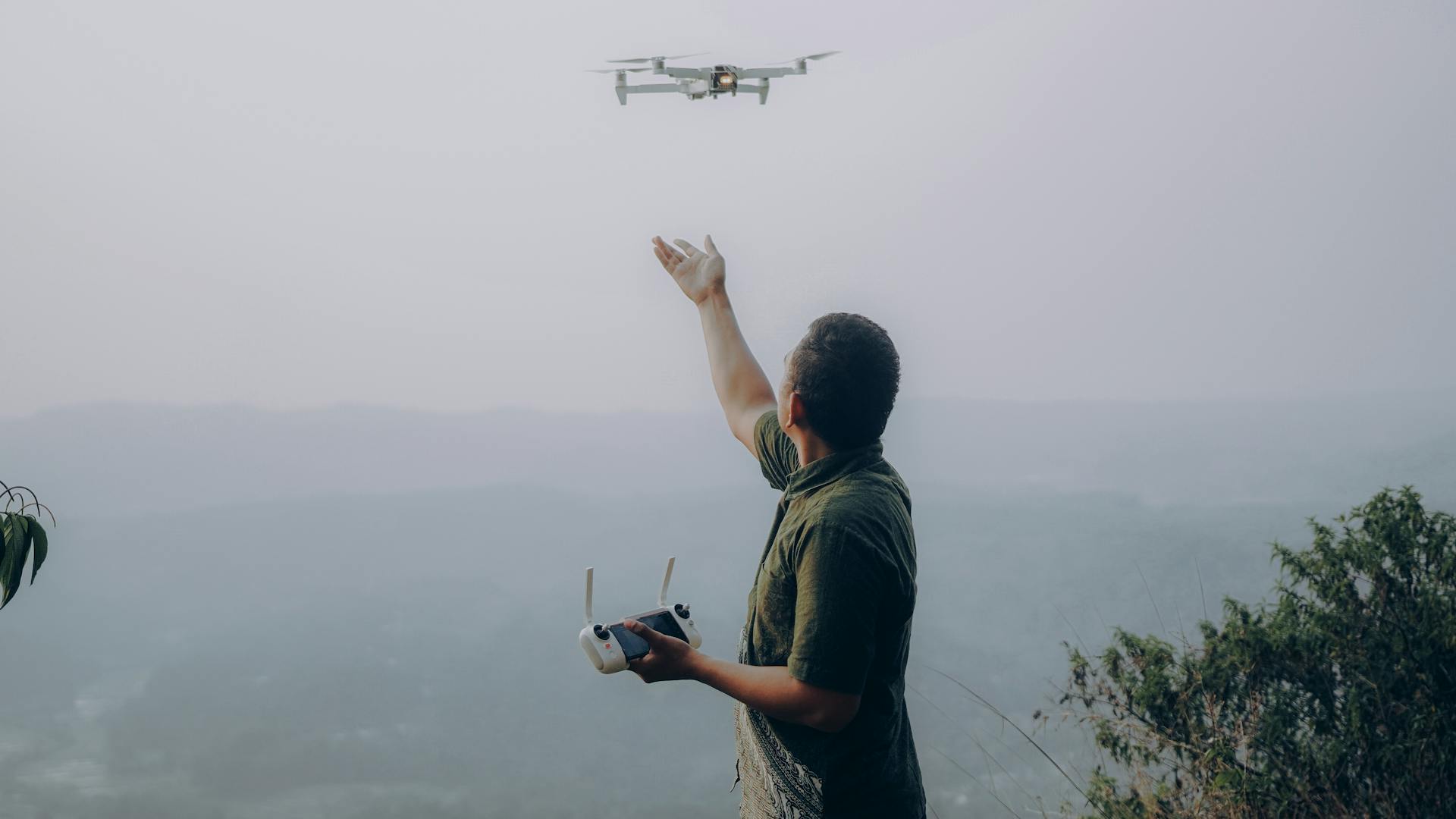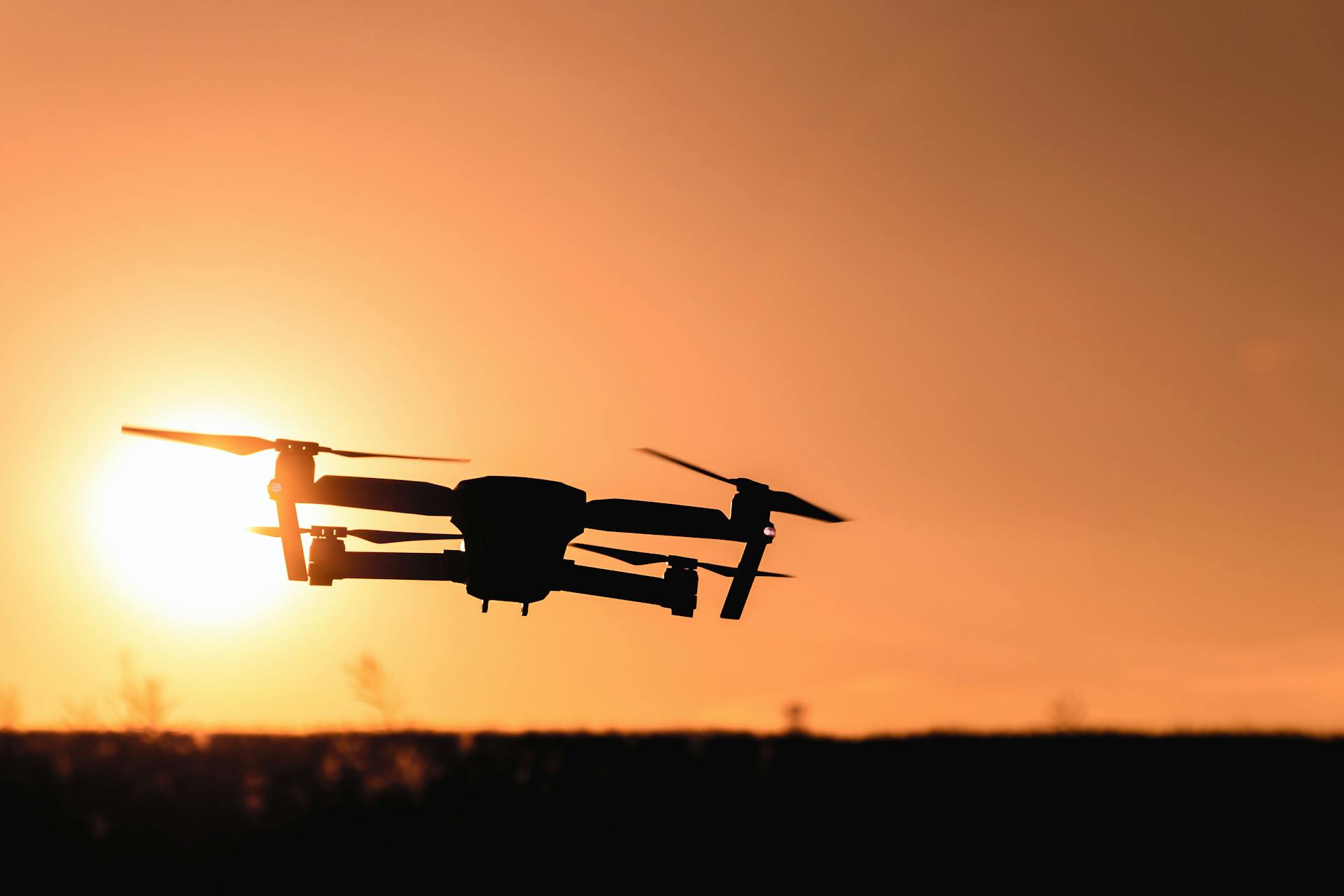
Military drone controller systems are a crucial component of modern military operations, allowing for real-time monitoring and control of drones from anywhere in the world. These systems enable military personnel to make quick decisions and respond to changing situations on the battlefield.
The ability to control drones remotely is a game-changer for military operations, providing a bird's-eye view of the battlefield and allowing for precision strikes. This technology has been used in various military applications, including surveillance and reconnaissance.
With the advancement of technology, military drone controller systems are becoming increasingly sophisticated, with features such as real-time video streaming and GPS tracking. This allows for more accurate and efficient operations, reducing the risk of friendly fire and civilian casualties.
For more insights, see: Dji - Mini 2 Se Drone with Remote Control
Military Drone Controllers
Military drone controllers play a crucial role in military operations, providing critical support for a range of intelligence missions, from observation to SIGINT. They enable real-time understanding of military environments and enhance situational awareness by intercepting communications and monitoring movement.
Tethered drones, in particular, remain operational for extended periods of time, up to 50 hours, and are invaluable assets in military operations due to their autonomy and ability to gather intelligence in non-visual areas.
The MQ-20 Avenger is a combat-focused UAV with a maximum altitude of 50,000 feet, providing a strategic advantage in military operations by offering high-altitude capabilities for both surveillance and precision strikes.
Here are some key features of military drone controllers:
- Tethered drones can remain operational for up to 50 hours.
- The MQ-20 Avenger has a maximum altitude of 50,000 feet.
- FPV drones are more cost-effective than artillery missiles.
RQ-4 Global Hawk
The RQ-4 Global Hawk is a highly efficient military drone used for reconnaissance. It's a high-altitude, long-endurance unmanned aerial vehicle that's been in combat since 2001.
Its maximum operational ceiling of 60,000 feet allows it to conduct extensive surveillance operations without detection. This is a significant advantage over manned platforms, which can be easily spotted by enemy forces.
The Global Hawk has a robust range of 14,150 miles, giving it the ability to gather intelligence over large areas. Its maximum payload capacity is 3,000 pounds, which can be equipped with advanced sensors and radar systems.
Explore further: Black Hawk Drone Military
Here are some key specifications of the RQ-4 Global Hawk:
- Weight: Maximum takeoff 32,250 lb
- Powerplant: Rolls-Royce F137-RR-100 turbofan (7,600 lb thrust)
- Performance: Speed 356.5 mph, Endurance 32+ hrs
The Global Hawk has undergone several upgrades, including the EQ-4B for communications relay and the Block 40 for advanced ground and cruise missile surveillance. These upgrades have enhanced its capabilities and made it an even more valuable asset for military operations.
MQ-20 Avenger
The MQ-20 Avenger is a combat-focused UAV that's got some impressive specs. It's powered by a single Pratt & Whitney PW545B turbofan engine, which gives it a thrust of 17.8 kN (4,000 lb).
The Avenger's maximum weight is 8,255 kg (18,200 lb), and it can reach a top speed of 740 km/h (460 mph). It's also got a ceiling of over 15,240 m (50,000 ft), making it a high-altitude performer.
Here are some key specs at a glance:
- Maximum Speed: 740 km/h (460 mph)
- Maximum Weight: 8,255 kg (18,200 lb)
- Maximum Altitude: 50,000 ft
- Endurance: 20 hours
The Avenger's endurance is impressive, with a 20-hour flight time. This makes it a great option for long-duration surveillance and reconnaissance missions.
Advantages and Features
Military drone controllers have revolutionized the way we conduct surveillance, reconnaissance, and combat operations. They offer rapid deployment and reactivity, allowing for quick response to changing situations.
One of the key advantages of military drone controllers is their payload capacity, which can include a range of sensors such as EO/IR, Laser RangeFinder, synthetic aperture radar, ground moving target indicator, and communication relays.
Long endurance is another significant benefit, with tethered drones capable of operating for up to 50 hours. This extended flight time enables drones to gather critical intelligence and conduct extended surveillance missions.
Increased safety for ground units is also a major advantage, as drones can perform tasks that would otherwise put personnel at risk.
Here are some of the key features of a military drone controller:
- Encrypted communication for secure data exchange between the drone and ground control station.
- Ability to change frequencies or operate multiple drones at different frequencies to minimize vulnerability to EW stations.
- Real-time video transmission for instant sharing of data from onboard cameras.
- Onboard sensor integration for a holistic view of the operational area.
- Compliance features to ensure adherence to relevant aviation regulations and military standards.
These features enable military drone controllers to operate effectively in a range of scenarios, from surveillance and reconnaissance to combat operations.
Design and Technology
Military drones are equipped with advanced sensors and cameras, such as obstacle avoidance, high-resolution imaging, and AI integration, allowing them to provide real-time data to authorities and law enforcement agencies.
These drones can operate in low-light conditions and cover large areas, making them an indispensable tool for maintaining vigilance and protecting against security breaches. Their ability to detect and respond to threats quickly and efficiently enhances overall security measures.
Researchers are exploring new materials that could reduce the weight of drones while increasing their structural integrity, such as nanomaterials and advanced composites. This could lead to drones that are both lighter and stronger, allowing them to reach higher altitudes and carry larger payloads without compromising performance.
The integration of AI in drone control is necessary to prevent unwanted complications, such as EW signals that can block drone signals. This can be achieved by programming drones with autonomous path-planning features that help navigate complex environments and identify and ignore EW signals.
Here are some key features that can be integrated into military drone software development:
- Autonomous path-planning features to navigate complex environments
- Autonomous return functionality to record routes and return to starting points
- Computer vision algorithms to detect and recognize objects of interest
- Real-time collision avoidance to prevent collisions and ensure safe navigation
Future drones are expected to be equipped with even more sophisticated sensors and communication systems, allowing for better data collection, real-time analysis, and secure communication with ground control.
X-47B
The X-47B is a combat demonstration UAV with a maximum altitude of 40,000 feet. It's an impressive feat of engineering.
Used by the U.S. Navy, the X-47B showcases advanced technologies for autonomous flight and carrier-based operations. This demonstrates the future potential of unmanned combat aircraft.
The X-47B is a tailless, jet-powered vehicle with a blended-wing-body design. This design allows it to be capable of semi-autonomous functions.
One of the key features of the X-47B is its powerplant, which is a 1 × Pratt & Whitney F100-220U turbofan engine. This engine provides the necessary power for the aircraft to operate.
The X-47B is equipped with two weapon bays, supporting up to 4,500 lb (2,000 kg) of ordnance. This is a significant amount of firepower for a UAV.
The X-47B's avionics are also noteworthy, with provisions for EO/IR, SAR, ISAR, GMTI, MMTI, and ESM. These advanced sensors and systems enable the aircraft to perform a variety of tasks.
The X-47B is capable of inflight refueling and carrier landings, both of which are crucial for extending its operational range and compatibility with manned systems.
Expand your knowledge: Drone Aircraft Carrier
Lightweight Materials
Lightweight Materials are a game-changer for drone construction. They enable drones to fly higher and farther without sacrificing performance.
Carbon Fiber is a popular choice for drone builders due to its lightweight and durable properties. It's perfect for creating agile and durable drones.
Advanced Composites, like those made from Fiberglass and Kevlar, offer impact resistance and low weight. This makes them ideal for long-lasting and lightweight drones.
Enhanced Altitude Performance is another key benefit of lightweight materials. By reducing lift force and using efficient batteries, drones can reach higher altitudes and stay airborne for longer.
The right material choice can make all the difference in a drone's performance. Here are some key characteristics to consider:
Enhanced Sensors and Communications
Military drones are equipped with advanced sensors and cameras, allowing them to provide high-resolution imaging and real-time data to authorities. These sensors enable drones to operate effectively in low-light conditions, enhancing overall security measures.
The X-47B drone, for example, has provisions for EO/IR, SAR, ISAR, GMTI, MMTI, and ESM, making it a cutting-edge technology in the field of military drones. This advanced avionics system allows for a wide range of capabilities, including surveillance and reconnaissance.
Suggestion: Most Advanced Drone Military
Future drones are expected to be equipped with even more sophisticated sensors and communication systems. These enhancements will allow for better data collection, real-time analysis, and secure communication with ground control.
Advanced sensors can operate effectively at higher altitudes, providing clearer and more detailed imagery and intelligence. For instance, the RQ-4 Global Hawk can operate at altitudes of up to 60,000 feet, providing real-time intelligence over vast areas.
The integration of advanced sensors and communication systems will be crucial in the development of future military drones. By providing real-time data and secure communication, drones will be able to operate more effectively and efficiently in a wide range of environments.
Here are some of the key features of advanced sensors and communication systems in military drones:
- EO/IR (electro-optical/infrared) sensors for high-resolution imaging
- SAR (synthetic aperture radar) sensors for surveillance and reconnaissance
- ISAR (inverse synthetic aperture radar) sensors for high-altitude surveillance
- GMTI (ground moving target indication) sensors for detecting moving targets
- MMTI (moving target indication) sensors for detecting moving targets
- ESM (electronic support measures) sensors for detecting and analyzing electronic signals
These advanced sensors and communication systems will enable military drones to operate more effectively and efficiently in a wide range of environments.
Modular Design
Modular design is a game-changer in the world of technology, and it's particularly exciting for drones. Modular drone designs will enable the quick adaptation of drones for various missions.
By swapping out different components, such as sensors, engines, or communication systems, military drones can be tailored for specific tasks. This flexibility is a huge advantage for military operations.
With modular design, drones can be easily upgraded or modified to suit changing mission requirements. This reduces the need for new, specialized drones to be manufactured.
Modular design also reduces waste and minimizes the environmental impact of drone production.
Enhanced Power Systems
Enhanced Power Systems are revolutionizing military drone capabilities, with advancements in both hybrid engines and battery technology that significantly extend operational range and altitude. This is a game-changer for surveillance and other missions that require extended flight times.
Hybrid Power Systems are a key advancement, combining fuel engine endurance with electric motor efficiency. This allows for switching between power sources for better fuel efficiency. The result is extended flight times, ideal for surveillance.
Battery Technology Improvements are also a major breakthrough, with lithium-ion and solid-state batteries improving power and reducing weight. This increases altitude capacity, reaching heights beyond fuel-only engines.
With these advancements, drones can now support heavier payloads without reducing flight duration. This means they can carry advanced equipment for versatile operations.
Here are the key features of Enhanced Power Systems:
Quick recharge capabilities also store energy efficiently for minimal downtime. This is a significant advantage for military drones that need to be ready for action at a moment's notice.
Acecore Signav Ultra
The Acecore Signav Ultra is a military-grade ground station built on the Panasonic FZ-M1.
It's drop, dust, and water resistant, earning it an IP65 rating.
The button layout is carefully chosen to work with high-end ISR sensors like the NextVision Raptor X80.
This remote is Windows-based, boasting 8GB RAM and a hot-swappable battery.
Its radio is configurable from the factory to fit in existing military networks or selected frequency bands.
Radio options include the Doodle Labs Helix and Persistent Systems MPU5.
Frequently Asked Questions
Are military drones controlled by an Xbox controller?
Yes, the Army and Marine Corps have used Xbox controllers to operate small unmanned vehicles, including drones, for over a decade. This innovative approach has been used for a variety of tasks, from explosive ordnance disposal to logistics operations.
What are military drone operators called?
Military drone operators are referred to as Remotely Piloted Aircraft (RPA) Pilots or Unmanned Aerial Vehicle (UAV) Operators. They play a critical role in various military operations, requiring specialized training and expertise.
How do military drones communicate with controllers?
Military drones communicate with controllers through a combination of remote control signals, navigation satellite signals, and map transmission signals. These signals enable real-time data exchange between the drone and its host, facilitating precise control and navigation.
Sources
- https://www.nsin.us/how-high-can-a-military-drone-fly/
- https://elistair.com/military-surveillance-drones/
- https://seclgroup.com/how-we-developed-a-military-fpv-drone/
- https://www.army-technology.com/data-insights/innovators-robotics-drone-flight-control-system-aerospace-defence/
- https://acecoretechnologies.com/controller-options/
Featured Images: pexels.com


